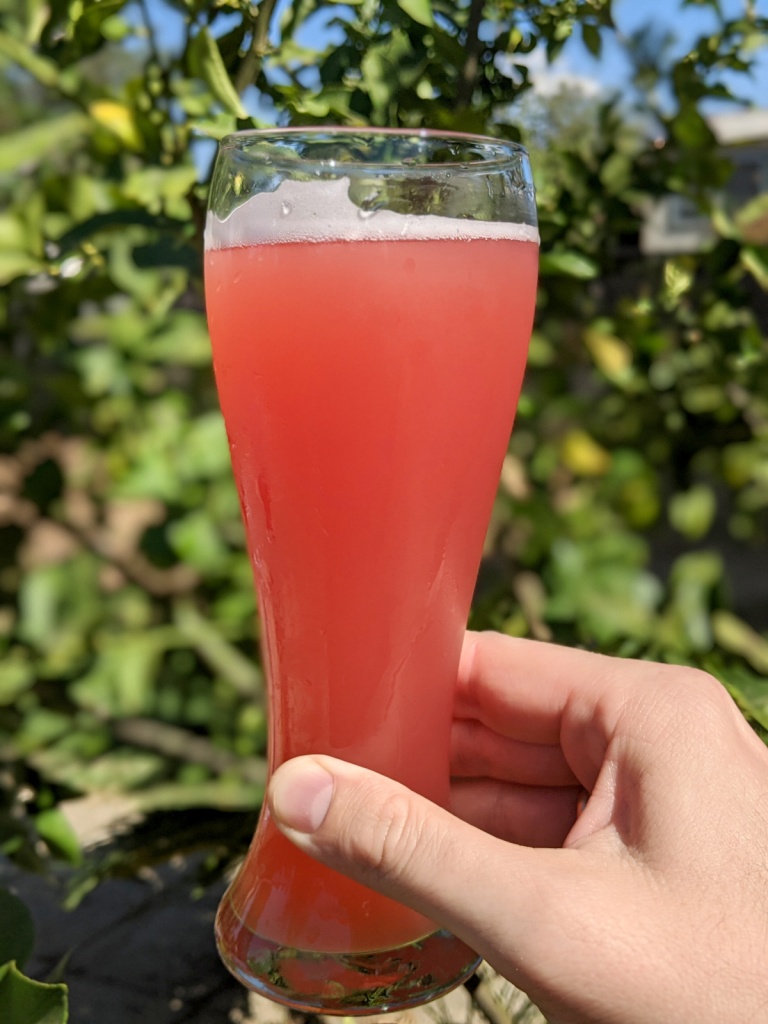According to my records, this is the fifth time I’ve made Raspberry Belgian. It is one of my favorite recipes, without a doubt. The process is a fair bit of work, and it’s not the cheapest thing to brew, but WOW, are the results worth it!

My approach to this has morphed considerably over the years, and there are inevitably some variations in ingredients and process. So, every time is different, even if they’re all more or less in the same flavor space.
As before, the key to this recipe is using fresh/frozen raspberries. Tons and tons of raspberries–4.5 pounds, to be precise. I used just frozen ones this time, which I thawed and pureed before adding to the fermenter. Canned purees just don’t “pop” in the same way. For souring, I tried out the Lactobacillus Blend from Omega Labs, which is what the local shop had on-hand. Past versions of the recipe used acidulated malt in the grist, which was a hold-over from the original “bacteria-free” version, and I decided to just ditch that because it was unnecessary.
Raspberry Belgian 2021
- 6.5 lb. Viking Pilsner Zero Malt
- 2.5 lb. white wheat malt (Great Western)
- 1 lb. flaked wheat
- 0.5 lb. Carapils malt (Briess)
- 0.5 lb. rice hulls
- 0.5 oz. Magnum hop pellets (10.1% alpha), 60 minute boil
- 1 tsp. WLN1000 yeast nutrient (White Labs), 10 minute boil
- 1 pkg. Belgian Wit Ale Yeast (WLP400), prepared in 1L vitality starter
- 1 pkg. Lactobacillus Blend (Omega Labs OYL-605)
- 72 oz. frozen raspberries, pureed
Target Parameters
- 1.048 o.g., 1.012 f.g., 18 IBU, 4 SRM, 4.8% abv
- 154° full-volume mash, 60 minutes
- Overnight kettle sour
- Claremont tap water, no adjustment
Procedure
- Way back in May, I made a starter for Pannotia White IPA using WLP400, but it was suuuuper slow to kick off. Worrying that it was dead, I got some Whiteout (Imperial Yeast), but kept the WLP400 starter going just in case. After a day or two, it was off to the races, and so I harvested the results to save for a later brew–which turned out to be the raspberry brew!
- I mashed in with 7.25 gallons of water at 160°, and held the mash at 154° for 60 minutes with recirculation. I added 7 mL of 88% lactic acid to adjust the mash pH. I raised the temperature to 168° for a 10 minute mash-out, and then removed the grain basket.
- In total, I collected 6.25 gallons of runnings with a gravity of 1.038, for 61% mash efficiency. This is a bit low, but that seems to be the case for these adjunct-heavy beers (and my mill seems to be not quite tight enough, after inspection of equipment).
- Next, I boiled the runnings for 5 minutes, before chilling down to 95°. I added 25 mL of 88% lactic acid, to get the pH down to 4.4, and then added the lacto culture. Because I’m using the Foundry, I just let the runnings in the kettle, and set it to maintain temperature at 90°. I did this step on 14 August 2021.
- After 25 hours, the pH was down to 3.5, right in my target range. I called this perfect!
- While getting the soured runnings ready, I made a SNS (shaken-not-stirred) starter for the harvested yeast culture.
- I boiled the runnings, adding hops and yeast nutrients per the recipe. After 60 minutes, I chilled the wort, transferred to the fermenter, and then chilled down to 66° before pitching the yeast starter.
- I started primary fermentation on 15 August 2021, holding at 66°.
- On 19 August 2021, I added 72 oz. of pureed frozen raspberries, and raised the temperature to 68°.
- On 22 August 2021, I brought the beer out to ambient, around 75° or so, to finish up.
- I kegged the beer on 28 August 2021. At this point, it had a final gravity of 1.013, which works out to 4.0% abv. With the extra sugars from the fruit, actual abv might be a touch higher.
Tasting
- Appearance
- The beer is gorgeous! I pours with a pink, frothy, and somewhat persistent head. The beer itself is dark pink, and moderately (but not overly) hazy. I think it’s looking clearer than might be usual, because I’m using a floating dip tube. I wouldn’t mind a little extra haze, if it helped augment the mouthfeel and flavor.
- Aroma
- Raspberry is prominent, with a bit of tartness also.
- Flavor
- The beer is moderately sour, but not over the top. The sour character is clean (one person who tasted it described it as a sour patch kid–that’s a high compliment in my book!). Bitterness is perceived as low. The raspberry comes through very nicely. There might be a slight wheat flavor, but in general I don’t think the malt is terribly perceptible. I’m a bit surprised that the Belgian yeast character doesn’t come through more, either.
- Mouthfeel
- This beer has a light body and effervescent quality, with a tart, modestly sour, and dry finish.
- Would I Brew This Again?
- This is a wonderful beer! It’s incredibly drinkable, especially during warm weather. I wouldn’t mind a touch more malt character and a little bit more prominent Belgian yeast character…I would be curious to see if it’s genuinely no Belgian character, or if that is just being covered up by the raspberries. Perhaps I’ll try fermenting at a higher temperature next time, to bring out the phenols more prominently. Those are truly minor issues, and really just in the category of optional tweaks to consider.
- Overall
- 9/10





